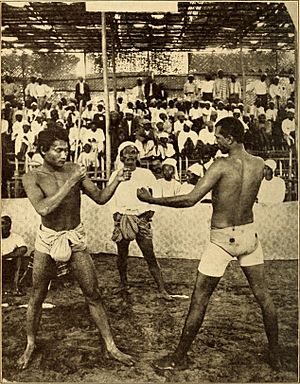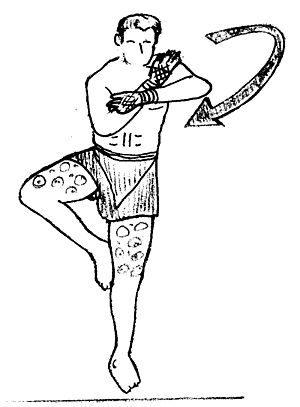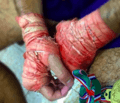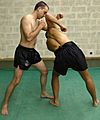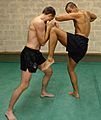Burmese boxing facts for kids
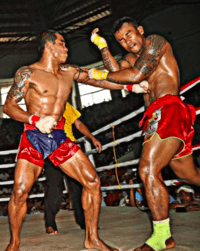 |
|
| Also known as | Burmese boxing Burmese bareknuckle boxing Myanmar traditional boxing The Art of 9 Limbs |
|---|---|
| Focus | Striking |
| Country of origin | |
Lethwei (Burmese: လက်ဝှေ့) is a full-contact sport from Myanmar. It is also known as Burmese boxing. People sometimes call it "The Art of 9 Limbs". This is because fighters use their hands, feet, elbows, knees, and head to strike. Lethwei is known for being a tough sport. Fighters do not wear gloves, and headbutts are allowed.
Contents
What is Lethwei?
Lethwei is an old style of fighting from Myanmar. It started around the 3rd century when monks wanted to learn how to defend themselves. This fighting style uses bare hands and feet. It became very popular in the 11th century under King Anawratha. Back then, fights between different tribes had very few rules.
Rules of the Game
In the old days, two referees judged the fights. Fighters could hit or throw in any way they wanted. Today, Lethwei has more rules, like other boxing sports. Fighters now use hand wraps instead of bare knuckles. They also have rounds and fight in a ring.
Lethwei fighters use many different moves. Some special moves include jumping kicks, knee strikes, and elbow strikes. They also use techniques where they step up to hit. In the past, Lethwei was very rough. Now, it is well-organized and fun to watch.
How Fighters Use Their Bodies
Lethwei is called "The Entire Body is a Weapon." This means fighters use almost every part of their body to attack. There are nine main "weapons" in Lethwei:
- The head (skull)
- Two fists
- Two elbows
- Two knees
- Two feet
Fighters aim to hit their opponent's body. They also use three main distances in a fight:
- Long distance: This is mostly for kicks.
- Middle distance: This is for knee strikes, fists, and elbows.
- Close distance: This is for holding and throwing opponents.
Fighters also use special plans to win. For example, they might hit an opponent's arms first. This can open a way to hit the body or face. They also use moves inspired by animals, like those in the thaing martial art. For example, a "wild boar" move might be a low blow. A "leopard" kick might target the arms to create an opening.
The Culture of Lethwei
Traditionally, Lethwei fights happened in a circle. Even today, in villages in Myanmar, the fights still keep their old customs. Only the use of a ring and rounds shows modern changes.
Two referees judge the match. Six other referees give points to the fighters. All kinds of moves are allowed. A fighter can even be hit when they are on the ground. The rounds are quite long. Other matches might happen during breaks between rounds.
Fighters wear simple gear. They have special boxing pants and wrapped hands. They might use a coconut shell for protection. Some fighters even have tattoos on their bodies. These tattoos can show their victories. Others show animals like eagles, snakes, leopards, or tigers. These animals represent strength and bravery.
Lethwei Yay: The Warrior Dance
Before a fight, Lethwei fighters perform a warrior dance called "Lethwei yay." This dance shows their skill and bravery. At the end of the dance, they hit their crossed arms against their shoulders. This shows that they are ready to fight. After the fight, if they win, they also do a victory dance.
Lekkha Moun: Showing Your Weapons
"Lekkha moun" is when a fighter shows off the "weapons" they will use. The fighter hits their opposite arm with an open hand. They do this from top to bottom. First, they show their fists and elbows. Then, they show their knees. Finally, they show their feet.
Images for kids
See also
 In Spanish: Lethwei para niños
In Spanish: Lethwei para niños


